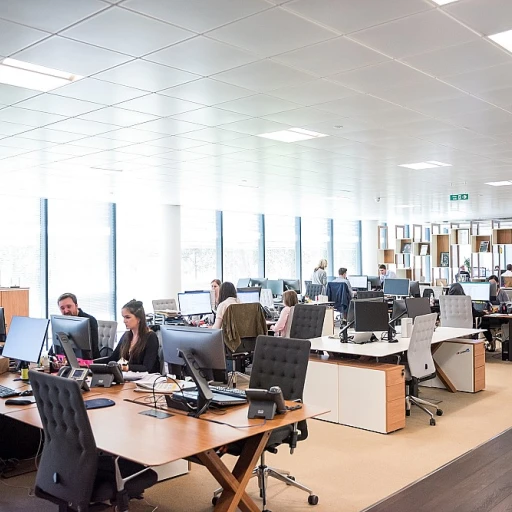
Understanding the Growth Mindset in the Workplace
Growth Mindset: A Key to Success in the Workplace
Understanding the concept of a growth mindset in the workplace is crucial for fostering an innovative and adaptive working environment. Unlike a fixed mindset, where individuals may see skills and intelligence as static traits, a growth mindset champions the belief that abilities can be developed through dedication, learning, and hard work. This perspective is not only beneficial for employees on a personal level but can significantly enhance business performance and development. Incorporating a growth mindset among employees encourages a culture of continuous learning and improvement. When team members see challenges as opportunities for growth rather than insurmountable obstacles, they are more likely to engage in problem-solving and take risks that can lead to innovations. This is particularly vital in today's fast-paced business climate where the only constant is change. L&D teams play a pivotal role in instilling a growth mindset culture within organizations. By providing opportunities for learning and development, these teams can help employees elevate their skills, adapt to change, and prepare for the future. Encouraging feedback is another essential component, as it helps employees learn from their experiences and enhance their skills. Creating an environment that supports growth and development leads to a more dynamic and resilient workforce. By fostering mindset growth, businesses can prepare their team members for leadership roles and contribute to long-term success. For more insights on how to effectively unlock potential for development in succession planning, explore this valuable resource.Identifying Key Growth Mindset Traits in Employees
Recognizing Traits That Drive Growth
In the workplace, identifying employees who exhibit a growth mindset is crucial for fostering a culture of continuous learning and development. These individuals are not only open to learning new skills but also demonstrate resilience in the face of challenges. Recognizing these traits can help businesses tailor their leadership and development programs effectively.
Key Characteristics of Growth-Oriented Employees
- Adaptability: Employees with a growth mindset are flexible and willing to adapt to new situations. They view changes as opportunities for growth rather than obstacles.
- Curiosity: A natural inclination to ask questions and seek knowledge is a hallmark of growth-minded individuals. They are eager to learn and explore new ideas.
- Resilience: These employees bounce back from setbacks and use failures as learning experiences. Their ability to persevere is a key factor in their success.
- Feedback Receptiveness: Growth-oriented employees actively seek feedback and use it constructively to improve their performance and skills.
- Problem-Solving Skills: They approach problems with a solution-focused mindset, often thinking creatively to overcome challenges.
Distinguishing Between Growth and Fixed Mindsets
Understanding the difference between growth and fixed mindsets is essential for identifying potential leaders within your team. Employees with a fixed mindset may resist change and shy away from challenges, believing their abilities are static. In contrast, those with a growth mindset embrace challenges and view them as opportunities to develop their skills.
For more insights on how to identify and nurture these traits in your team, consider exploring key leadership training topics that can enhance your succession planning efforts.
Strategies for Encouraging a Growth Mindset
Encouraging an Evolving Perspective in the Workplace
Cultivating a growth mindset within a work environment requires intentional and strategic efforts tailored to encourage continuous development among employees and team members. Adopting specific strategies to foster this mindset ensures that businesses not only embrace change but also thrive through it. Firstly, it is crucial to emphasize the importance of a mindset centered around learning and development. Encourage team activities that challenge individuals to step outside their comfort zones. Whether it’s through problem-solving exercises or innovative team projects, providing opportunities for employees to tackle new challenges helps reduce the barriers of a fixed mindset. Secondly, providing constructive and regular feedback is a beneficial approach. Open communication channels where employees receive recognition for their growth while also receiving guidance on areas of improvement contribute to a culture of openness and learning. This practice also helps in nurturing leadership skills among team members as they learn to accept criticism in a constructive manner. Moreover, establish a mentorship program that pairs employees with experienced leaders within the organization. This initiative paves the way for a mentorship-based leadership, allowing individuals to learn from the experiences of others. Mentorship can significantly aid in developing growth mindsets by equipping employees with the insights and skills needed for personal and professional growth. Facilitating regular workshops and training sessions to reinforce the value of a growth mindset is equally essential. Encouraging participation in these programs empowers employees with the tools needed for continuous learning, ultimately contributing to the business's success. Organizations that integrate such initiatives into their learning and development (L&D) strategies typically observe a more active and engaged workforce. Additionally, fostering a mindset culture that celebrates failures as learning experiences rather than mistakes can significantly influence individuals’ growth. It reinforces the idea that setbacks are an integral part of the growth journey. Cultivating an environment where employees feel safe to make mistakes encourages risk-taking and, subsequently, innovation. Finally, it's important for organizations to continuously assess and measure the efficacy of these strategies in nurturing growth mindsets. Implementing regular evaluations of these initiatives can provide insights into what is working and what might require adjustment. By doing so, businesses can maintain the momentum needed to support individuals in developing a growth mindset, ultimately contributing to their success and the organization's growth. For further exploration of how leadership can benefit from such initiatives, one might consider reviewing the practices of specialized executive development institutes. Explore leadership benefits from these institutes.Creating a Supportive Environment for Growth
Fostering a Nurturing Atmosphere for Continuous Learning
Creating a supportive environment for growth is paramount when fostering a growth mindset among employees. A workplace culture that prioritizes continuous learning encourages team members to step out of their comfort zones, embrace challenges, and persist despite setbacks. This mindset culture focuses on developing leadership qualities and unlocking individual potential, paving the way for success in the business realm. The role of leadership in promoting a growth mindset cannot be understated. Leaders should model a growth mindset by openly sharing their own learning journeys, acknowledging areas where they have struggled, and providing constructive feedback. When leadership embraces learning and development, it sets a precedent for the entire team. Implementing regular training sessions and workshops can aid in developing growth mindsets. By offering resources tailored to learning development, businesses can support employees in mastering new skills. Additionally, collaborative activities and group problem-solving sessions foster a sense of teamwork and encourage mindset growth. Here are some practical steps to encourage a nurturing growth mindset culture:- Encourage Open Communication: Create avenues for employees to voice their thoughts, ideas, and concerns openly. This not only encourages feedback but also cultivates an inclusive mindset workplace where every individual feels valued.
- Recognize and Reward Efforts: Acknowledge employees for their efforts and perseverance, even when outcomes are not successful. This approach strengthens the message that development is a journey, not a destination.
- Provide Mentorship Opportunities: Connect employees with mentors who can guide their growth journey, offering insights and encouragement. Mentorship is a powerful tool for expanding skills and fostering a learning mindset.
- Create a Safe Failing Environment: Encourage taking calculated risks and learning from failures. When employees know they won’t face punitive measures for mistakes, they are more likely to experiment and innovate.
Measuring the Impact of a Growth Mindset on Succession Planning
Assessing the Influence of a Growth-Oriented Approach on Advancement Planning
To effectively gauge the influence of implementing a growth mindset within your workforce, particularly in relation to succession planning, you must first understand how a growth-oriented mindset impacts your business’s core objectives. Embracing a culture where employees are encouraged to learn and develop can significantly shape your succession strategy.Here's how fostering a learning mindset can benefit your succession planning:
- Enhanced Leadership Potential: Employees with a growth mindset are more likely to pursue leadership roles and tackle complex challenges within the organization. This is crucial for succession planning as it ensures a broader pool of capable individuals ready to step into senior positions.
- Increased Employee Engagement: When team members are invested in their personal and professional development, they often demonstrate greater engagement. This leads to a more cohesive work environment, which directly contributes to smoother transitions in leadership roles.
- Adaptability and Innovation: A growth mindset encourages employees to adopt a flexible approach to problem solving and innovation. This mindset can lead to creative solutions and strategies during periods of change within leadership ranks.
- Continuous Learning and Feedback Culture: Encouraging a culture where individuals are open to feedback and eager to learn enhances skills critical for leadership roles. This environment not only supports personal growth but also aligns with the goals of long-term success in your succession plans.
To measure the impact, businesses can track metrics such as employee retention rates, internal promotions, and the speed at which developmental feedback translates into actual skill improvements. Moreover, employee surveys can offer insights into how team members perceive the growth culture and its effects on their career paths.












